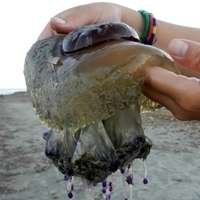'Trojan horse' effect may explain jellyfish blooms

(Phys.org)—Man-made structures such as harbours, tourist facilities, oil rigs and aquaculture farms provide ideal sanctuaries for jellyfish polyps to flourish and may explain an apparent increase in jellyfish blooms in many coastal waters around the world.
That's the conclusion of a new study published by a group of international researchers, including lead author Winthrop Professor Carlos Duarte, Director of the Oceans Institute at The University of Western Australia.
Their paper Is global ocean sprawl a cause of jellyfish blooms? appeared this week in the journal Frontiers in Ecology and the Environment.
Professor Duarte said most theories that seek to explain increased jellyfish blooms focus on jellyfish at their more mature swimming stage and factors such as a lack of predators or competitors due to overfishing.
But the new study examined the tiny polyp phase of jellyfish and found they congregate in millions on the underside of man-made structures.
"We call this new proposition the 'Trojan Horse' hypothesis," Professor Duarte said.
"The proliferation of artificial structures such as harbours, shipping facilities and aquaculture structures provides a habitat for jellyfish polyps and may be an important driver in explaining the global increase in jellyfish blooms."
Professor Duarte said jellyfish larvae typically settle on a hard surface and grow into polyps as part of a colony. The polyps are generally inconspicuous because they are very small - usually only a millimetre or so in length.
The study examined polyps growing on a variety of man-made structures around the world - including in Japan, Britain, Spain and Slovenia - and looked under docks, piers, pontoons and artificial reefs, and on the underside of oysters attached to piers.
"Jellyfish polyps existed on the underside of such artificial structures at densities of more than 10,000 individuals per square metre, and sometimes up to 100,000 per square metre," Professor Duarte said.
Research was also conducted in Chesapeake Bay in the US and in a laboratory with a Mediterranean jellyfish species to examine how larvae settled on oyster shells, flagstones and 16 other surfaces, including bricks, ropes, cans, wood, concrete and plastic.
Journal information: Frontiers in Ecology and the Environment
Provided by University of Western Australia
















